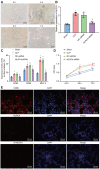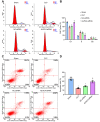NLRC4 gene silencing-dependent blockade of NOD-like receptor pathway inhibits inflammation, reduces proliferation and increases apoptosis of dendritic cells in mice with septic shock
- PMID: 33406504
- PMCID: PMC7835030
- DOI: 10.18632/aging.202379
NLRC4 gene silencing-dependent blockade of NOD-like receptor pathway inhibits inflammation, reduces proliferation and increases apoptosis of dendritic cells in mice with septic shock
Abstract
Septic shock is one of the most significant health concerns across the world, involving hypo-perfusion and defects in tissue energy. The current study investigates the role of NLR family CARD domain containing protein 4 (NLRC4) in septic shock-induced inflammatory reactions, lung tissue injuries, and dendritic cell (DC) apoptosis. Septic shock mice models were established by modified cecal ligation and puncture and injected with retroviral vector expressing siRNA-NLRC4. DCs were then isolated and transfected with siRNA-NLRC4. The degree of lung tissue injury, cell cycle distribution, cell apoptosis and cell viability of DCs were assessed. NLRC4 was found to be expressed at high levels in mice with septic shock. NLRC4 silencing inhibited the activation of the NOD-like receptor (NLR) pathway as evidenced by the decreased levels of NOD1, NOD2, RIP2, and NF-κB. In addition, NLRC4 silencing reduced the inflammatory reaction as attributed by reduced levels of IL-1β, TNF-α and IL-6. Suppressed NLRC4 levels inhibited cell viability and promoted cell apoptosis evidenced by inhibited induction of DC surface markers (CD80, CD86, and MHC II), along with alleviated lung tissue injury. In conclusion, NLRC4 silencing ameliorates lung injury and inflammation induced by septic shock by negatively regulating the NLR pathway.
Keywords: NLRC4; NOD-like receptor pathway; immune response; inflammatory reaction; septic shock.
Conflict of interest statement
Figures







Similar articles
-
AMPK as a potential pharmacological target for alleviating LPS-induced acute lung injury partly via NLRC4 inflammasome pathway inhibition.Exp Gerontol. 2019 Oct 1;125:110661. doi: 10.1016/j.exger.2019.110661. Epub 2019 Jul 15. Exp Gerontol. 2019. PMID: 31319131
-
Glaucocalyxin A alleviates LPS-mediated septic shock and inflammation via inhibiting NLRP3 inflammasome activation.Int Immunopharmacol. 2020 Apr;81:106271. doi: 10.1016/j.intimp.2020.106271. Epub 2020 Feb 12. Int Immunopharmacol. 2020. PMID: 32062071
-
Redundant and cooperative interactions between TLR5 and NLRC4 in protective lung mucosal immunity against Pseudomonas aeruginosa.J Innate Immun. 2015;7(2):177-86. doi: 10.1159/000367790. Epub 2014 Nov 12. J Innate Immun. 2015. PMID: 25402425 Free PMC article.
-
NLRP12 collaborates with NLRP3 and NLRC4 to promote pyroptosis inducing ganglion cell death of acute glaucoma.Mol Neurodegener. 2020 Apr 15;15(1):26. doi: 10.1186/s13024-020-00372-w. Mol Neurodegener. 2020. PMID: 32295623 Free PMC article.
-
Multifaceted Functions of NOD-Like Receptor Proteins in Myeloid Cells at the Intersection of Innate and Adaptive Immunity.Microbiol Spectr. 2016 Aug;4(4). doi: 10.1128/microbiolspec.MCHD-0021-2015. Microbiol Spectr. 2016. PMID: 27726775 Review.
Cited by
-
Genetic polymorphisms, biomarkers and signaling pathways associated with septic shock: from diagnosis to therapeutic targets.Burns Trauma. 2024 May 6;12:tkae006. doi: 10.1093/burnst/tkae006. eCollection 2024. Burns Trauma. 2024. PMID: 38716051 Free PMC article. Review.
-
[NLRC4 plays a regulatory role in F. nucleatum-induced pyroptosis in macrophages].Nan Fang Yi Ke Da Xue Xue Bao. 2022 Oct 20;42(10):1560-1565. doi: 10.12122/j.issn.1673-4254.2022.10.17. Nan Fang Yi Ke Da Xue Xue Bao. 2022. PMID: 36329592 Free PMC article. Chinese.
-
Comparative analysis of intestinal microbiota composition and transcriptome in diploid and triploid Carassius auratus.BMC Microbiol. 2023 Jan 2;23(1):1. doi: 10.1186/s12866-022-02709-5. BMC Microbiol. 2023. PMID: 36593453 Free PMC article.
-
Identification of key genes related to immune cells in patients with gram-negative sepsis based on weighted gene co-expression network analysis.Ann Transl Med. 2022 Jul;10(14):787. doi: 10.21037/atm-22-3307. Ann Transl Med. 2022. PMID: 35965814 Free PMC article.
-
Role of inflammasomes in acute respiratory distress syndrome.Thorax. 2025 Mar 18;80(4):255-263. doi: 10.1136/thorax-2024-222596. Thorax. 2025. PMID: 39884849 Free PMC article. Review.
References
-
- Meyer NJ, Ferguson JF, Feng R, Wang F, Patel PN, Li M, Xue C, Qu L, Liu Y, Boyd JH, Russell JA, Christie JD, Walley KR, Reilly MP. A functional synonymous coding variant in the IL1RN gene is associated with survival in septic shock. Am J Respir Crit Care Med. 2014; 190:656–64. 10.1164/rccm.201403-0586OC - DOI - PMC - PubMed
MeSH terms
Substances
LinkOut - more resources
Full Text Sources
Other Literature Sources
Research Materials

